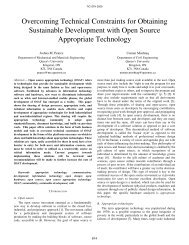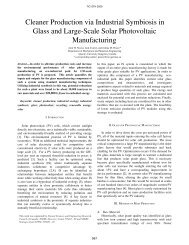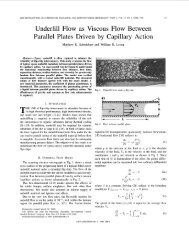Optimizing greenhouse gas mitigation strategies to suppress energy
Optimizing greenhouse gas mitigation strategies to suppress energy
Optimizing greenhouse gas mitigation strategies to suppress energy
You also want an ePaper? Increase the reach of your titles
YUMPU automatically turns print PDFs into web optimized ePapers that Google loves.
2nd Climate Change Technology Conference<br />
2ième Conférence sur les technologies du changement climatique<br />
May 12-15 mai 2009, Hamil<strong>to</strong>n, Ontario, Canada<br />
In this paper: i) a generalized process will be derived for determining the <strong>energy</strong> cannibalism<br />
for a given <strong>energy</strong> technology, ii) the limits on the growth rate set by <strong>energy</strong> cannibalism will<br />
be discussed in the context of climate stabilization, iii) complications <strong>to</strong> future projects of net<br />
emissions will be outlined, iv) the scale of the <strong>energy</strong> problem will be quantified and the<br />
necessary growth rates will be generalized for GHG emission mitigating <strong>energy</strong> technology<br />
(ET – for both renewable <strong>energy</strong> producing and <strong>energy</strong> conserving technologies). Finally, the<br />
impact the concept of <strong>energy</strong> cannibalism will have on the economics of climate change<br />
<strong>mitigation</strong> will be discussed. Conclusions and recommendations are made from the analysis<br />
<strong>to</strong> assist decision makers in optimizing deployment of technologies on large scales <strong>to</strong> reduce<br />
GHG emissions <strong>to</strong> safe stable levels.<br />
2. Energy cannibalization due <strong>to</strong> rapid growth<br />
2.1 Energy payback time and GHG emission conservation payback time<br />
Due <strong>to</strong> the contamination of the current <strong>energy</strong> mix with fossil fuel combustion, all current<br />
technologies are dependent <strong>to</strong> some degree on fossil fuel <strong>energy</strong> and thus also contribute <strong>to</strong><br />
GHG emissions. In order for an ET <strong>to</strong> have a net negative impact on GHG emissions of the<br />
<strong>energy</strong> supply, first it must produce enough emission-less <strong>energy</strong> or conserve enough <strong>energy</strong><br />
<strong>to</strong> offset the emissions that it is responsible for, and then it must continue <strong>to</strong> produce <strong>energy</strong><br />
or conserve <strong>energy</strong> <strong>to</strong> offset emissions from existing or potential fossil fuel plants. Many<br />
technologies are candidates for meeting these requirements such as renewable sources of<br />
<strong>energy</strong> (wind power, solar power, microhydro, etc.) and <strong>energy</strong> conserving technologies (e.g.<br />
solid state lighting, insulation, Energy Star appliances, etc.). These requirements, however,<br />
can become challenging in view of rapid growth because the construction of additional ET<br />
production plants <strong>to</strong> enable the rapid growth rate, creates emissions that cannibalize the GHG<br />
<strong>mitigation</strong> potential of all the ET plants viewed as a group.<br />
To illustrate this point it is helpful <strong>to</strong> view all ET plants of a given type as a single aggregate<br />
plant or ensemble and look at the ensemble's ability <strong>to</strong> mitigate emissions as it grows [13].<br />
This ability is first dependent on the <strong>energy</strong> payback time (t EP ) of the plant, or the amount of<br />
time it takes for a given device <strong>to</strong> produce (or conserve) as much <strong>energy</strong> as it <strong>to</strong>ok <strong>to</strong><br />
construct. For a generic <strong>energy</strong> producing technology (or <strong>energy</strong> conserving technology), an<br />
installed <strong>to</strong>tal capacity, C T (in GW), produces (or conserves):<br />
N<br />
E T<br />
=tC T<br />
=t∑ C n (1)<br />
n=1<br />
of <strong>energy</strong> per year, where t is the time the plant is running at capacity in hours in a year, C n is<br />
the capacity of an individual ET and N is the <strong>to</strong>tal number of ETs.<br />
If we assume that in the same year the industry of that technology grows at a rate, r, it<br />
will produce an additional capacity of rC T . It should be made clear here that the analysis is<br />
based on a standard unit of time – a year. The amount of <strong>energy</strong> that the industry produces (or<br />
conserves) is obtained by multiplying by the time and is thus rC T t. In order <strong>to</strong> keep the<br />
Page 2 of 9








